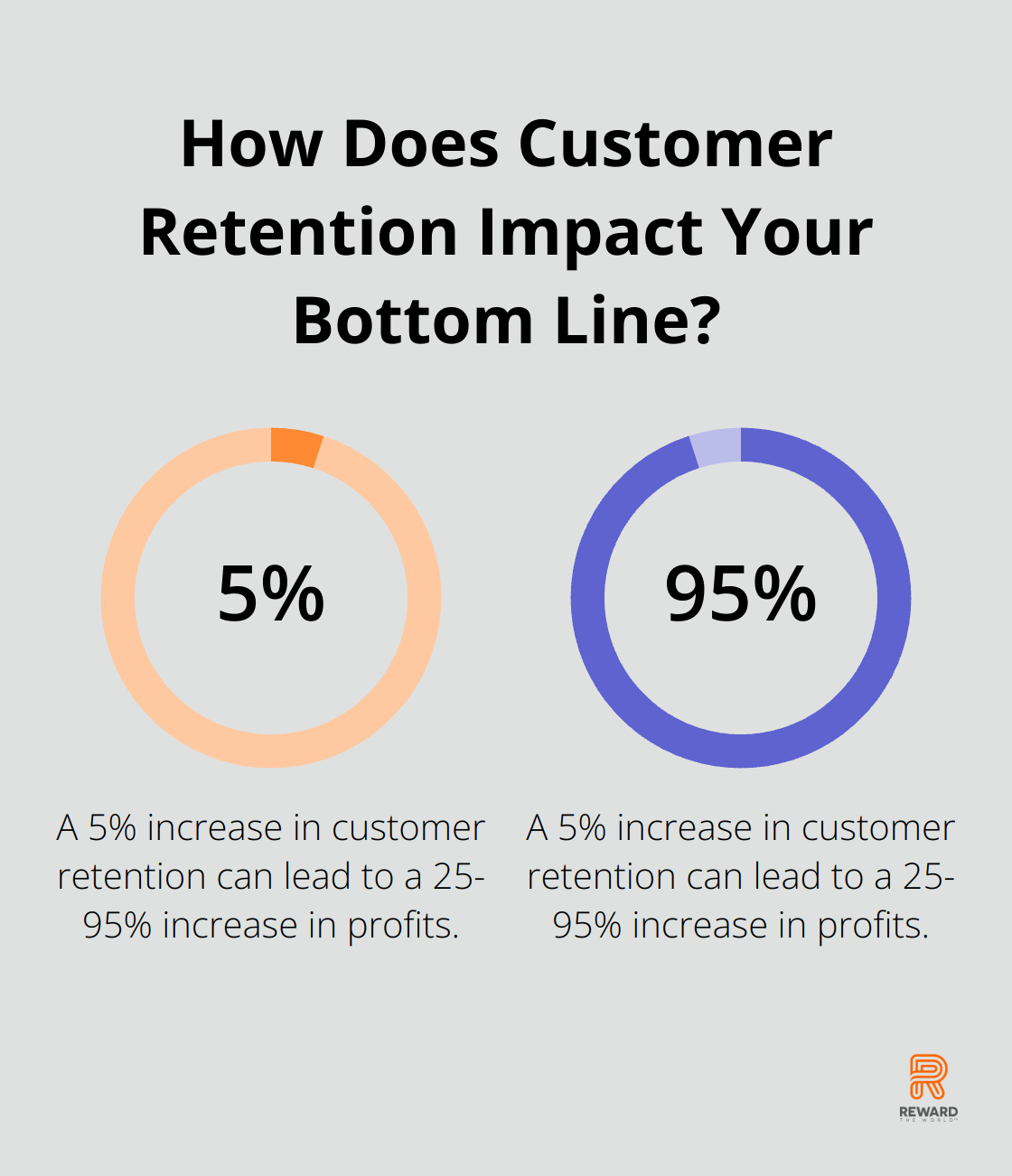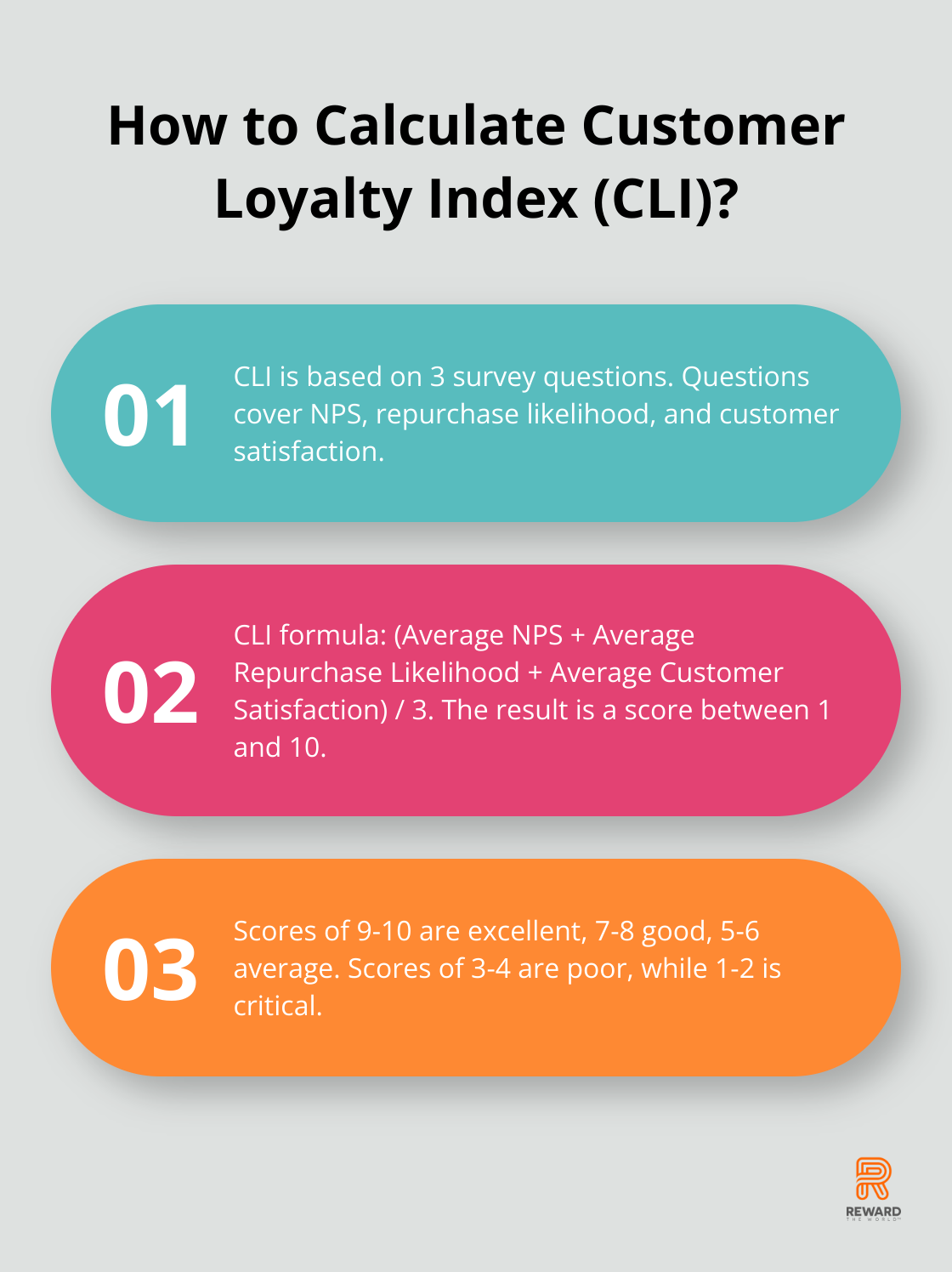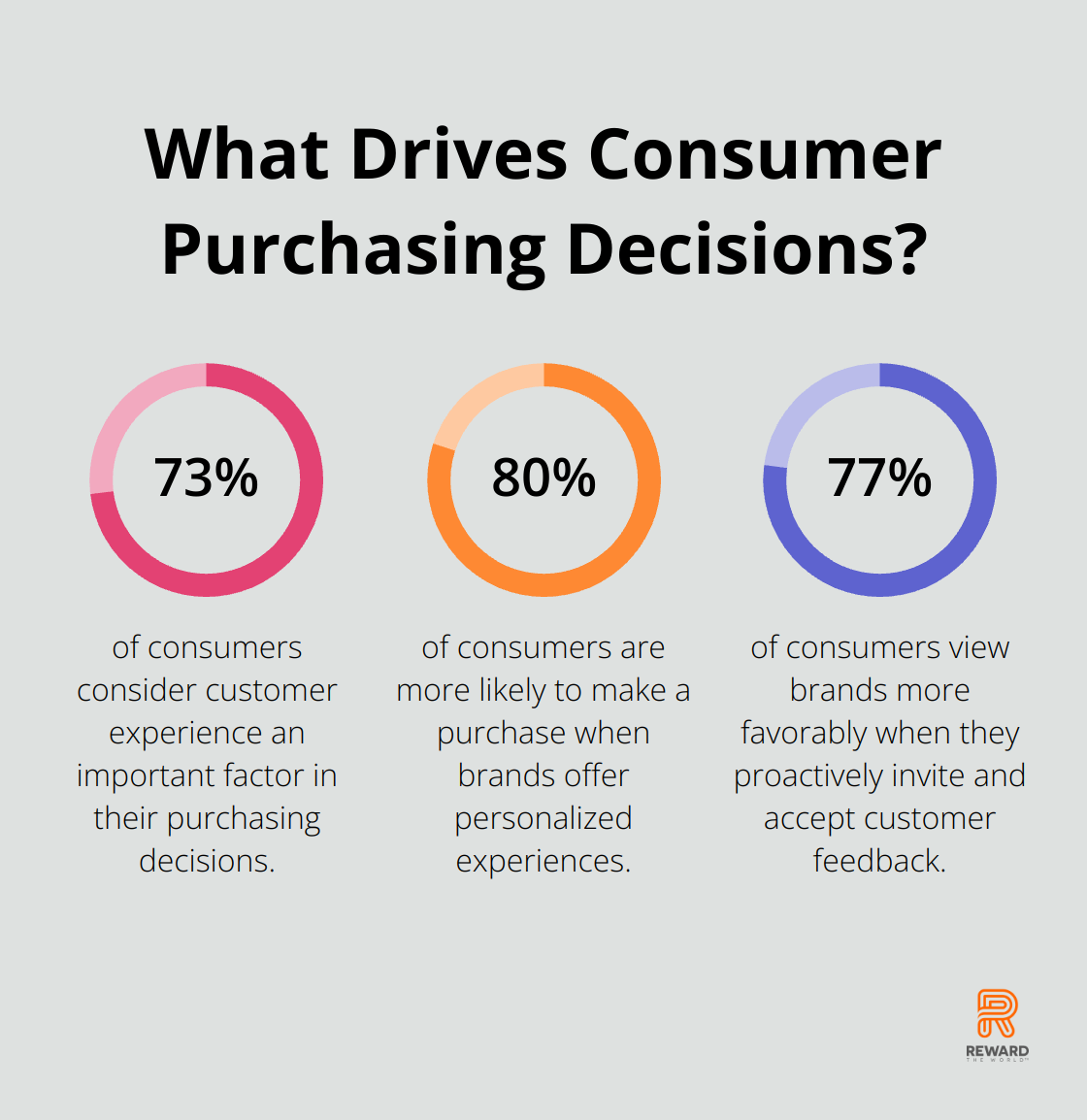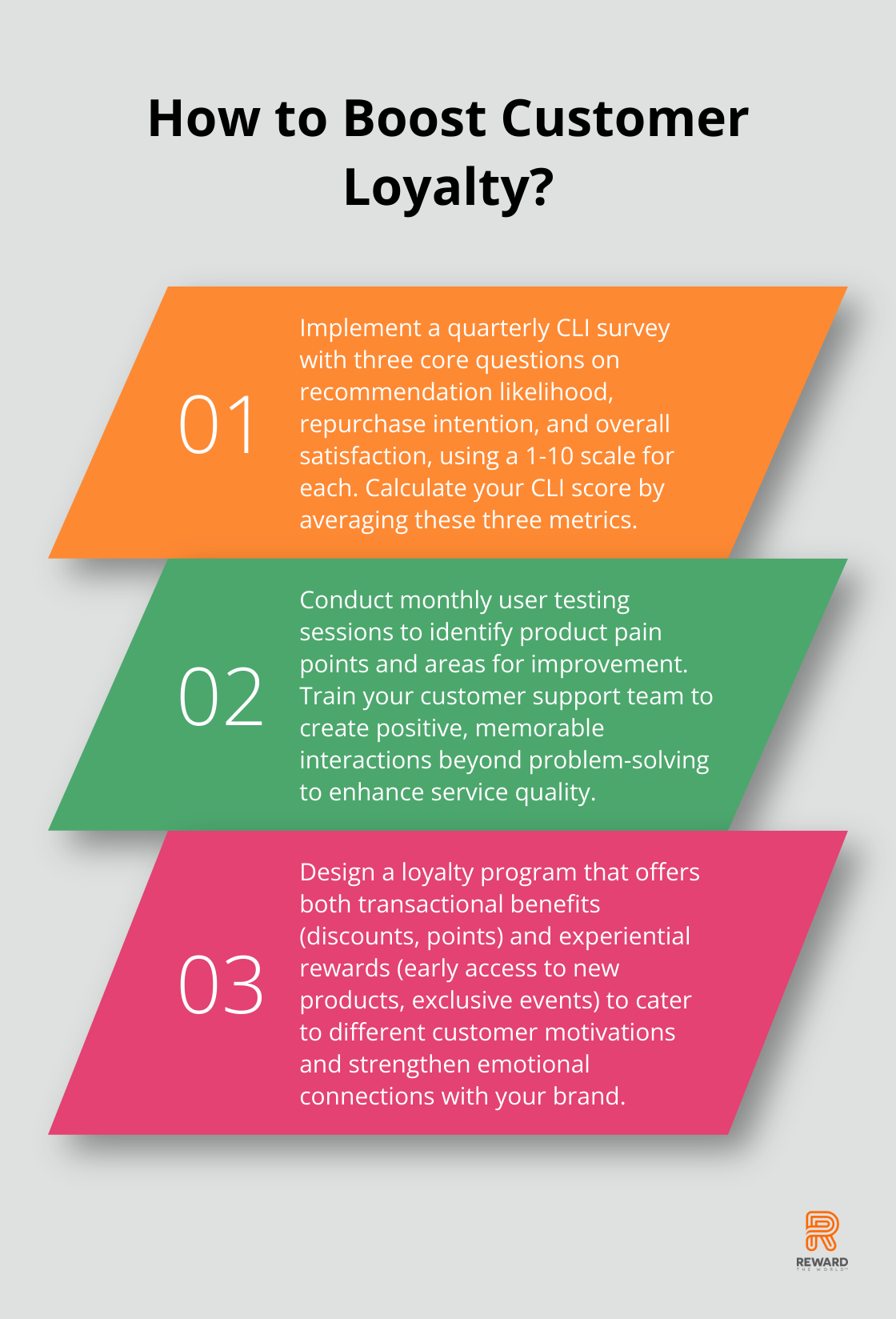
At Reward the World, we know that customer loyalty is the backbone of any successful business. The Customer Loyalty Index (CLI) is a powerful tool that measures and quantifies this crucial aspect of your customer relationships.
In this post, we’ll break down what CLI is, how to calculate it, and share effective strategies to boost your scores. Get ready to transform your approach to customer retention and drive long-term business growth.
What Is the Customer Loyalty Index?
Definition and Key Components
The Customer Loyalty Index (CLI) is a powerful metric that quantifies the strength of customer relationships. This numerical score reflects the likelihood of customers to remain loyal to a brand, make repeat purchases, and recommend it to others.

The CLI typically combines three key elements:
- Net Promoter Score (NPS): Measures the likelihood of customers to recommend the brand.
- Repurchase Likelihood: Gauges the probability of customers making future purchases.
- Customer Satisfaction: Assesses overall contentment with products or services.
By integrating these factors, the CLI offers a comprehensive view of customer loyalty that extends beyond simple satisfaction scores.
Importance of Measuring Customer Loyalty
Tracking CLI is essential for several reasons. It serves as a strong indicator of future business performance. A study by Bain & Company revealed that a 5% increase in customer retention can lead to a 25-95% increase in profits, demonstrating the significant impact loyal customers have on the bottom line.
Loyal customers also act as brand advocates. They’re more likely to leave positive reviews, refer friends, and defend the brand on social media.
CLI vs. Other Customer Metrics
While metrics like Customer Satisfaction (CSAT) or Net Promoter Score (NPS) provide valuable insights, they only tell part of the story. CSAT focuses on short-term satisfaction, while NPS measures the likelihood to recommend. The CLI, however, provides a more holistic view of customer loyalty.
Consider this scenario: a customer might express satisfaction with a one-time purchase (high CSAT) but have no intention of buying again. Similarly, they might recommend a brand for a specific product (high NPS) but not display loyalty across the entire product range. The CLI captures these nuances, offering a more accurate picture of long-term customer value.
The Role of CLI in Business Growth
Companies that prioritize CLI often see significant improvements in their overall performance. These businesses tend to experience:
- Higher customer retention rates
- Increased customer lifetime value
- More effective word-of-mouth marketing
- Reduced acquisition costs
By focusing on CLI, businesses don’t just measure customer loyalty – they actively cultivate it for long-term success. This approach sets the stage for sustainable growth and a competitive edge in the market.
Now that we understand what the Customer Loyalty Index is and why it matters, let’s explore how to calculate this valuable metric for your business.
How to Calculate Your Customer Loyalty Index
Designing Your CLI Survey
The foundation of an accurate CLI calculation lies in a well-crafted survey. Your questionnaire should include three core questions:
- How likely are you to recommend our product/service to a friend or colleague? (NPS)
- How likely are you to purchase from us again in the future? (Repurchase Likelihood)
- How satisfied are you with your overall experience with our company? (Customer Satisfaction)

Each question should be answered on a scale of 1-10, with 10 being the most positive response.
Collecting and Analyzing Data
Once you’ve designed your survey, it’s time to gather responses. Try to collect a representative sample of your customer base. A good rule of thumb is to collect at least 200 responses for every 1 million customers.
After collecting responses, calculate the average score for each of the three questions. Then, use this formula to determine your CLI:
CLI = (Average NPS + Average Repurchase Likelihood + Average Customer Satisfaction) / 3
This will give you a score between 1 and 10.
Interpreting Your CLI Score
Understanding your CLI score is essential for making informed business decisions. Here’s a general guideline for interpreting your results:
9-10: Excellent. Your customers are highly loyal and likely to be strong brand advocates.
7-8: Good. Customers are satisfied but there’s room for improvement.
5-6: Average. You meet basic expectations but don’t exceed them.
3-4: Poor. Immediate action is needed to address customer concerns.
1-2: Critical. Your business risks losing customers rapidly.
Your CLI is not a static number. It’s a dynamic metric that you should track over time to identify trends and measure the impact of your customer loyalty initiatives.
Frequency of Measurement
How often should you calculate your CLI? Quarterly assessments work well for most businesses. This frequency allows you to track changes over time while providing enough data points to identify meaningful trends.
However, if you operate in a fast-paced industry or implement significant changes to your customer experience, monthly calculations might be more appropriate. On the other hand, for businesses with longer sales cycles or less frequent customer interactions, semi-annual or annual calculations might suffice.
Regular CLI calculations and analysis will equip you with valuable insights into your customer relationships. These insights will help you make data-driven decisions to improve loyalty. In the next section, we’ll explore strategies to boost your CLI score and strengthen your customer relationships.
How to Boost Your Customer Loyalty Index
Elevate Product and Service Quality
The foundation of customer loyalty rests on the quality of your offerings. A PwC study found that 73% of consumers consider customer experience an important factor in their purchasing decisions. To improve your CLI, conduct a thorough audit of your products or services. Identify areas where you can enhance quality, functionality, or user experience.

Software companies should implement regular user testing sessions to uncover pain points and areas for improvement. Retail businesses should focus on sourcing higher-quality materials or improving manufacturing processes to enhance product durability.
Customer service plays an equally important role. Train your support team to create positive, memorable interactions (beyond mere problem-solving). Zappos, known for its exceptional customer service, maintains a 75% customer retention rate by empowering its support team to take necessary steps to ensure customer satisfaction.
Personalize Marketing Efforts
Personalization is a must-have for boosting customer loyalty. Research from Epsilon indicates that 80% of consumers are more likely to make a purchase when brands offer personalized experiences.
Segment your customer base using data such as purchase history, browsing behavior, and demographic information. Use this data to create targeted email campaigns, personalized product recommendations, and tailored content.
A clothing retailer could send personalized style guides based on a customer’s past purchases and browsing history. A SaaS company might offer customized onboarding experiences tailored to the user’s role and experience level.
Implement a Robust Loyalty Program
A well-designed loyalty program can significantly impact your CLI. Starbucks Rewards saw a 16% increase in active membership in 2022, demonstrating the power of an effective loyalty strategy.
When designing your loyalty program, offer a mix of transactional benefits (like discounts or points) and experiential rewards (such as early access to new products or exclusive events). This approach caters to different customer motivations and strengthens emotional connections with your brand.
Reward the World offers a comprehensive platform for businesses looking to implement or enhance their loyalty programs. With its vast reward options and seamless integration capabilities, it provides a powerful tool for boosting customer engagement and loyalty.
Harness Customer Feedback
Actively seek and act on customer feedback to improve your CLI. Microsoft reports that 77% of consumers view brands more favorably when they proactively invite and accept customer feedback.
Implement regular surveys, monitor social media mentions, and analyze customer support interactions to gather insights. Create a systematic process for reviewing and acting on this feedback.
If multiple customers suggest a new feature for your product, add it to your development roadmap. If you receive complaints about a specific aspect of your service, address it promptly and communicate the changes back to your customers.
Measure and Refine Your Approach
Improving CLI requires consistent effort and a genuine commitment to your customers’ satisfaction. Regularly measure the impact of your strategies and refine your approach based on the results.
Try to establish key performance indicators (KPIs) that align with your CLI goals. These might include customer retention rates, repeat purchase frequency, or average order value. Monitor these metrics closely and adjust your strategies as needed to continually improve your Customer Loyalty Index.
Final Thoughts
The Customer Loyalty Index (CLI) provides valuable insights into customer relationships and helps businesses identify areas for improvement. Companies that prioritize CLI often experience higher retention rates, increased customer lifetime value, and more effective word-of-mouth marketing. Regular measurement and analysis of CLI through well-designed surveys enable data-driven decision-making and targeted strategies to enhance customer satisfaction.

Improving CLI requires a multifaceted approach that focuses on product quality, personalized marketing, and robust loyalty programs. Active solicitation and implementation of customer feedback also play a vital role in fostering stronger, more lasting customer relationships. These strategies, when executed consistently, can significantly impact CLI and contribute to overall business growth.
At Reward the World, we understand the importance of customer loyalty in business success. Our comprehensive rewards platform offers a solution for businesses looking to enhance their customer loyalty initiatives. With a wide range of reward options (and seamless integration capabilities), we help companies create meaningful connections with their customers and drive engagement.
